Christof Lehmann (nsnbc) : Russia and neighboring Belarus launched their joint Zapad (West) 2017 military exercise spanning from the northern top of Scandinavia to Belarus and Russia’s western military sector. The Zapad 2017 exercise is scheduled between September 14 to 20. It is officially set to involve 12,700 However, it is not uncommon for Russia to include sudden movements of troops in military drills to test readiness. The total potential number of troops is about 100,000 rather than the nominal 12,700.
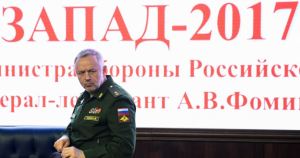 Both Russia and Belarus have assured their western neighbors that they have no ill intentions, that the Zapad 2017 drill as exclusively defensive, and that the involved troops pose no threat to neighbors. Governments and populations in the Baltic countries including Estonia, Lituania, Latvia, who once were forced to become members of the Soviet Union.
Both Russia and Belarus have assured their western neighbors that they have no ill intentions, that the Zapad 2017 drill as exclusively defensive, and that the involved troops pose no threat to neighbors. Governments and populations in the Baltic countries including Estonia, Lituania, Latvia, who once were forced to become members of the Soviet Union.
People in Finland, the Scandinavian country that was attacked by the Soviet Union after it first gained its independence from Russia, and people in Poland who are looking back on Soviet occupation do not necessarily feel safer because Moscow makes promises. That said, many in the Baltic States, in Poland, or for that sake in Germany, don’t feel very comfortable with being a membership of NATO either.
 The exercise has already caused diplomatic tensions between Finland and Russia. The government and military of Finland barred the Russian bark Kruzenshtern, operated as school ship for the Russian Navy, from docking in Mariehamn during the Russia – Belarus Zapad 2017. Russian officials had asked permission for the 91-year-old four-master bark to dock in Mariehamn in Finland’s demilitarized Åland province between September 28 -30. However, the vessel was denied docking rights by the defense forces of Finland.
The exercise has already caused diplomatic tensions between Finland and Russia. The government and military of Finland barred the Russian bark Kruzenshtern, operated as school ship for the Russian Navy, from docking in Mariehamn during the Russia – Belarus Zapad 2017. Russian officials had asked permission for the 91-year-old four-master bark to dock in Mariehamn in Finland’s demilitarized Åland province between September 28 -30. However, the vessel was denied docking rights by the defense forces of Finland.
The dates coincidde with the joint Russian -Belarus Zapad 2017 military exercises. However, 2017 is also the 100th anniversary of Finland’s declaration of independence from Russia. Finland’s declaration of independence from Russia was adopted on December 6, 1917, ending its “autonomy” within Russia as the “Arch Dutchy of Finland”. In November 1917 the Bolshevik government accepted Finland’s right to full self-determination including the right to secession. However, Russia and Finland have since been involved in two extremely bloody wars, nearly resulting in Finland being “re-absorbed by an expansionist Soviet Union.
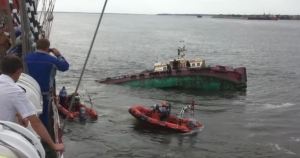 The Kruzenshtern was originally built in 1926 at Geestemünde in Bremerhaven, Germany. The ship was confiscated as a war trophy by the Soviet Union in 1946 as “reparation for World War II”. The vessel now belongs to a Russian academy in Kaliningrad that trains cadets in “marine research”. The “history” of the vessel makes the request to have it dok in the demilitarized Åland province even more controversial.
The Kruzenshtern was originally built in 1926 at Geestemünde in Bremerhaven, Germany. The ship was confiscated as a war trophy by the Soviet Union in 1946 as “reparation for World War II”. The vessel now belongs to a Russian academy in Kaliningrad that trains cadets in “marine research”. The “history” of the vessel makes the request to have it dok in the demilitarized Åland province even more controversial.
So much to the importance of recent history in contemporary politics… Now, British Defense Secretary Michael Fallon told reporters on September 10 that “This is designed to provoke us, it’s designed to test our defenses, and that’s why we have to be strong.” Any reasonably honest military expert or analyst will admit that most exercises of a nature similar to that of the Zapad 2017 are designed to “test the potential adversary and his responses, to provoke responses which force the potential adversary to reveal defense strategies and structures – no insignificant feat considering that nuclear-armed powers are involved – and to show strength.
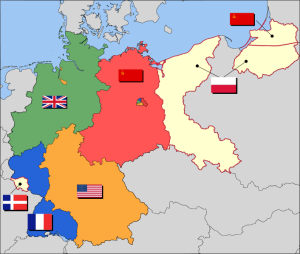
Post-WW II German occupation borders and territories. Areas in beige indicate territories east of the Oder-Neisse line that were attached to Poland and the USSR. The Saar Protectorate, on the lefthand side of the map, is also shown in beige. Berlin is the multinational area shown within the red Soviet zone. (source: Wikipedia)
Russia for its part denounces concerns expressed by western neighbors as alarmism. Moscow rejects criticism about the fact that the Zapad 2017 are the first drills to be held in such close proximity to NATO member states since the Crimea crisis in 2014. The usual PR strategy aims to stress that one of the preconditions Moscow had for the reunification of Germany was that NATO would not expand to former Warsaw Pact member States.
That there has been such an oral agreement has been confirmed by former Soviet leader Mikhail Gorbachev as well as by former French Foreign Minister Roland Dumas. It may be tue, but … international law allows deceit as an instrument of war. Besides, there is the question how Moscow wants to justify the interference in the internal affairs of former Warsaw Pact members as precondition for ending the occupation of eastern Germany.
But back to the number of troops involved in Zapad 2017. Moscow insists that the size of the exercise will not cross the 13,000-troop threshold that, under the Organization for Security and Cooperation in Europe (OSCE) rules known as the Vienna Document. Anything beyond that would require Moscow to notify other countries and open the maneuvers to observers, which it did, anyway, and probably in the anticipation that it then can add “the unexpected” movements to the maneuvers.
Colonel General Andrei Kartapolov, commander of Russia’s Western Military District, said in an interview published by the Russian military’s official Krasnaya Zvezda newspaper on September 13 that the number of troops and hardware used in the drills “will fully comply with the Vienna Document.” The Zapad exercise is held every four years in rotation with drills in other parts of Russia.
Western governments have responded to Russia’s 2014 seizure of Ukraine’s Crimean Peninsula – or according to Moscow Crimea’s “accession into the Russian Federation – and to the backing of separatists in eastern Ukraine with several waves of economic and other sanctions targeting Moscow. NATO has also slightly bolstered its presence in its easternmost member states that were dominated by Moscow during the Cold War and remain concerned about the Kremlin’s intentions in the region. Increases in numbers of NATO troops and in some cases of US troops are, however, a symbolic statement rather than of strategic or even tactical significance.
NATO Secretary-General Jens Stoltenberg said in Estonia last week that the military alliance would send three observers. “But these invitations fall short from the transparency required by the OSCE: briefings on the exercise scenario and progress, opportunities to talk to individual soldiers and overflights of the exercise,” Stoltenberg told reporters on September 6 during his visit to a NATO contingent in Tapa, Estonia. “We will monitor the [Zapad 2017] activity closely, and we are vigilant but also calm, because we don’t see any imminent threat against any NATO ally,” Stoltenberg added.
Kartapolov, for his part, told Krasnaya Zvezda that in addition to the stated 12,700 troops — around 7,200 from Russia and 5,500 from Belarus — Zapad 2017 included about 70 aircraft and up to 680 pieces of military hardware, including tanks, artillery units, and ships. During the drills, the joint Russian-Belarus operations are targeting a theoretical adversary attempting to undermine the government in Minsk and establish a separatist stronghold in western Belarus. This scenario echoes Russian concerns over what Moscow calls Western-orchestrated political revolutions in its backyard, most notably in Georgia in 2003 and in Ukraine, where President Viktor Yanukovych, a Kremlin ally, was ousted in early 2014. The United States and the European Union have repeatedly rejected such allegations, calling those events the result of grassroots anger against corrupt regimes in the former Soviet republics. Evidence shows that the truth lies somewhere in-between – in that legal, political and military limbo.
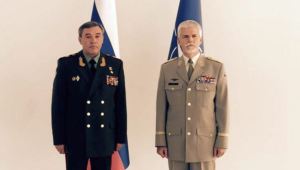 Now, behind all this posturing and positioning is also a clear interest in keeping lines of communication between Russia and NATO open. On September 7 General Petr Pavel, Chairman of the NATO Military Committee and General Valery Gerasimov, Chief of the General Staff of the Armed Forces of the Russian Federation and First Deputy Minister of Defense met in Baku, Azerbaijan.
Now, behind all this posturing and positioning is also a clear interest in keeping lines of communication between Russia and NATO open. On September 7 General Petr Pavel, Chairman of the NATO Military Committee and General Valery Gerasimov, Chief of the General Staff of the Armed Forces of the Russian Federation and First Deputy Minister of Defense met in Baku, Azerbaijan.
NATO would state that this face to face meeting demonstrates a clear mutual interest to maintain the military lines of communication, in line with NATO’s policy of transparency and ongoing dialogue at the political level with senior Russian leadership. General Pavel and General Gerasimov agreed to continue using the military lines of communication in the future.
CH/L – nsnbc 14.09.2017
Source Article from https://nsnbc.me/2017/09/14/subversion-in-limboland-russia-belarus-launch-zapad-2017-military-exercise/
 RSS Feed
RSS Feed















 September 14th, 2017
September 14th, 2017  Awake Goy
Awake Goy 










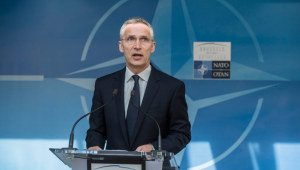
 Posted in
Posted in  Tags:
Tags: 













